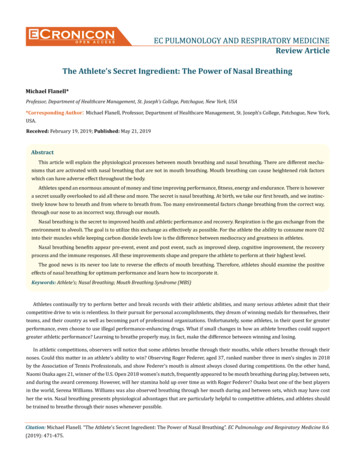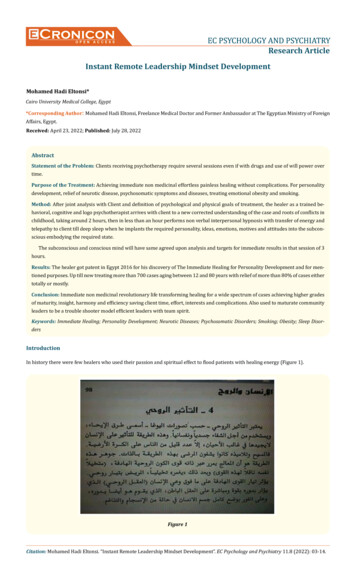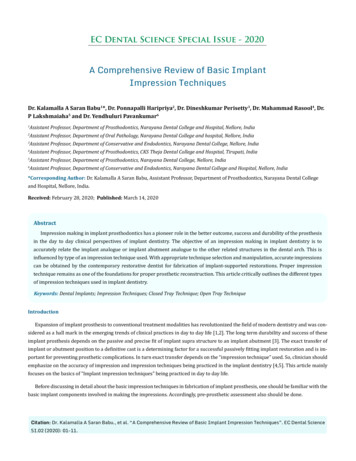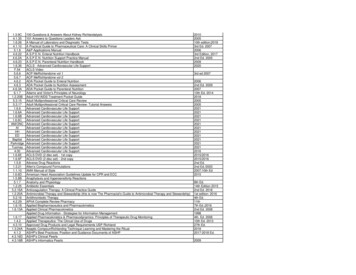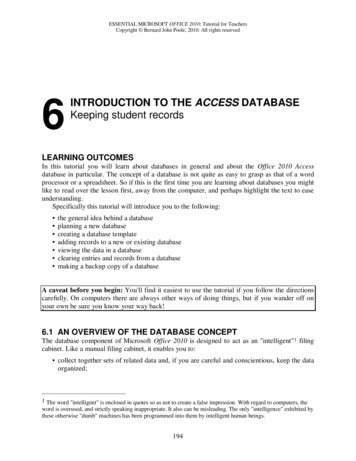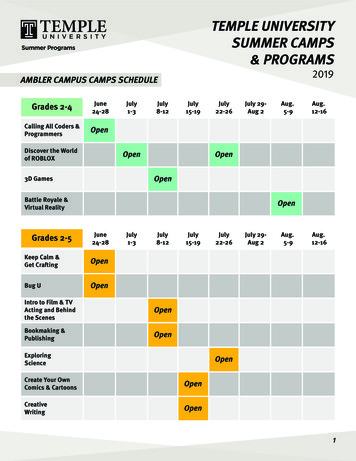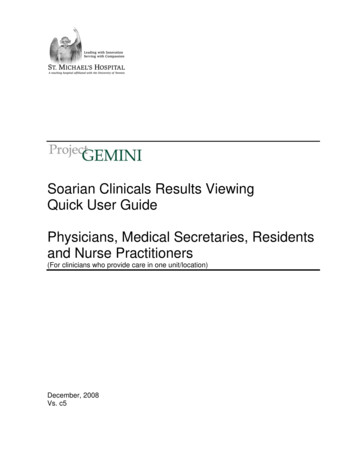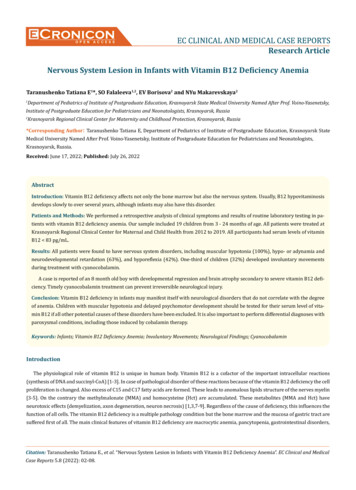
Transcription
CroniconO P ENA C C ESSEC CLINICAL AND MEDICAL CASE REPORTSResearch ArticleNervous System Lesion in Infants with Vitamin B12 Deficiency AnemiaTaranushenko Tatiana E1*, SO Falaleeva1,2, EV Borisova2 and NYu Makarevskaya21Department of Pediatrics of Institute of Postgraduate Education, Krasnoyarsk State Medical University Named After Prof. Voino-Yasenetsky,Institute of Postgraduate Education for Pediatricians and Neonatologists, Krasnoyarsk, Russia2Krasnoyarsk Regional Clinical Center for Maternity and Childhood Protection, Krasnoyarsk, Russia*Corresponding Author: Taranushenko Tatiana E, Department of Pediatrics of Institute of Postgraduate Education, Krasnoyarsk StateMedical University Named After Prof. Voino-Yasenetsky, Institute of Postgraduate Education for Pediatricians and Neonatologists,Krasnoyarsk, Russia.Received: June 17, 2022; Published: July 26, 2022AbstractIntroduction: Vitamin B12 deficiency affects not only the bone marrow but also the nervous system. Usually, B12 hypovitaminosisdevelops slowly to over several years, although infants may also have this disorder.Patients and Methods: We performed a retrospective analysis of clinical symptoms and results of routine laboratory testing in patients with vitamin B12 deficiency anemia. Our sample included 19 children from 3 - 24 months of age. All patients were treated atKrasnoyarsk Regional Clinical Center for Maternal and Child Health from 2012 to 2019. All participants had serum levels of vitaminB12 83 pg/mL.Results: All patients were found to have nervous system disorders, including muscular hypotonia (100%), hypo- or adynamia andneurodevelopmental retardation (63%), and hyporeflexia (42%). One-third of children (32%) developed involuntary movementsduring treatment with cyanocobalamin.A case is reported of an 8 month old boy with developmental regression and brain atrophy secondary to severe vitamin B12 defi-ciency. Timely cyanocobalamin treatment can prevent irreversible neurological injury.Conclusion: Vitamin B12 deficiency in infants may manifest itself with neurological disorders that do not correlate with the degreeof anemia. Children with muscular hypotonia and delayed psychomotor development should be tested for their serum level of vita-min B12 if all other potential causes of these disorders have been excluded. It is also important to perform differential diagnoses withparoxysmal conditions, including those induced by cobalamin therapy.Keywords: Infants; Vitamin B12 Deficiency Anemia; Involuntary Movements; Neurological Findings; CyanocobalaminIntroductionThe physiological role of vitamin B12 is unique in human body. Vitamin B12 is a cofactor of the important intracellular reactions(synthesis of DNA and succinyl-CoA) [1-3]. In case of pathological disorder of these reactions because of the vitamin B12 deficiency the cellproliferation is changed. Also excess of C15 and C17 fatty acids are formed. These leads to anomalous lipids structure of the nerves myelin[3-5]. On the contrary the methylmalonate (MMA) and homocysteine (Hct) are accumulated. These metabolites (MMA and Hct) haveneurotoxic effects (demyelization, axon degeneration, neuron necrosis) [1,3,7-9]. Regardless of the cause of deficiency, this influences thefunction of all cells. The vitamin B12 deficiency is a multiple pathology condition but the bone marrow and the mucosa of gastric tract aresuffered first of all. The main clinical features of vitamin B12 deficiency are macrocytic anemia, pancytopenia, gastrointestinal disorders,Citation: Taranushenko Tatiana E., et al. “Nervous System Lesion in Infants with Vitamin B12 Deficiency Anemia”. EC Clinical and MedicalCase Reports 5.8 (2022): 02-08.
Nervous System Lesion in Infants with Vitamin B12 Deficiency Anemia03cardiomyopathy, reproductive dysfunction and hard neurological deviations as seizures, coma, depressions, psychosis, atrophic changesin brain and optic nerve [2,10-14]. Neurological disorders occur independently of hematological in any age [1,6,8].Vitamin B12 is not synthesized in the human body. Adults may tolerate vitamin B12 deficient diets for many years without apparentsymptoms due to their endogenous stores [3]. The vitamin B12 deficiency can occur in infancy in case of vitamin B12 deficiency ofmothers because of low cobalamin fetus store level and low concentration in the breast milk [3,7,10,11,14,16].Purpose of the StudyAn analysis of the signs and symptoms of the nervous system damage in infants with vitamin B12 anemia was performed.Materials and MethodsInfants admitted to regional hospital (Krasnoyarsk Regional Clinical Center for Maternity and Childhood Protection) between 2012 to2019 and suffered from vitamin B12 deficiency anemia were included in this study.Retrospective analysis of clinical symptoms was performed. All infants were assessed by clinical and neurological examinations.Laboratory investigations included blood count, peripheral blood smear, serum screening as well as vitamin B12 and folic acid level.Serum vitamin B12 level was 83 pg/mL in all cases. The level of folic acid was normal.Cranial ultrasound was performed in all children. Electroencephalography (EEG) was performed in 15 children. Computer tomography(CT) was performed in 6 patients.The treatment was performed by next regime: cyanocobalamin form in solution 0,5 mg/ml (Russian Federation) 5 mcg/kg every dayby intramuscular or intravenous injection until reticulocytes increasing achieved, then 1 injection every other day until the normalizationof hemoglobin level. Then the treatment has been continued in outpatient department.Statistic analysis included correlation analyses by Spearman’s rank coefficients (rS) to identify the relationship between the parameters,and Wilcoxon T-test account for evaluation of the dynamics of test results after cyanocobalamin treatment. The median (Me), upper (Q1)and lower quartile (Q3) are used to describe nonparameric parameters.Results of the StudyOf 19 patients aged 3 - 24 month (Me - 8 mo, Q1-5,5 mo, Q3-15 mo), 10 children were males and 9 - females. All children had beenexclusively breast fed. Disease experience was from 2 week to 6 months. The patients condition was severe. Clinical signs and symptomsare presented in table 1. All children had changes in neurological status (Table 1). The main neurological symptoms were hypotonia (in100% cases), low muscular activity (63%). 32% children had adynamia. The correlation analysis is refuted the possible connection of thedetected motor disorders and muscular hypotension with the degree of anemia (rS 0,02, p 0,5). On 12 children (63%) had retardationin motor activities (regress of acquired skills). 2 children had seizures, 3 infants - tremor before cobalamin treatment.SymptomSomatic statusFatigueLow-grade feverWeight lossPallorWaxy skinIcteric skinHyperpigmentationPetechiaeGunther glossitisAphthous stomatitisTachycardia at restVomitingDysphagiaHepatomegaly at palpationSplenomegaly ( 1,5-2 см)Constipation for 3 to 7 daysNeurological statusMuscular hypotoniaHypo- and adynamiaLowed tendon reflexes (bicipital and patellar)Lowed abdominal reflexesReduced palatal reflexTremorStructural epilepsy including West syndromeInvoluntary movements due to therapy with cyanocobalaminProportion (%)19/19 (100%)1/19 (5%)10/19 (53%)19/19 (100%)13/19 (68%)6/19 (32%)5/19 (26%)6/19 (32%)8/19 (42%)1/19 (5%)13/19 (68%)8/19 (42%)5/19 (26%)11/19 (58%)7/19 (37%)3/19 (16%)19/19 (100%)12/19 (63%)8/19 (42%)7/19 (37%)7/19 (37%)3/19 (16%)2/19 (11%)6/19 (32%)Table 1: Clinical symptoms in infants with vitamin B12 anemia.Citation: Taranushenko Tatiana E., et al. “Nervous System Lesion in Infants with Vitamin B12 Deficiency Anemia”. EC Clinical and MedicalCase Reports 5.8 (2022): 02-08.
Nervous System Lesion in Infants with Vitamin B12 Deficiency Anemia04Cranial CT (in 6 children) detected brain atrophy and demyelination features. Laboratory changes presented in table 2 and 3.Thrombocytopenia was in 63% patients. Leucopenia and pancytopenia was in 26% patients. Hemolytic process was detected in 79%.ParameterМе (Q1-Q3)BaselineHb, g/L1Ht, %RBCs, х 1012 cells/LReticulocytes, %1MCV, fLMCH, pgMCHC, g/LRDW-CV, %67 (60-80)24,0 (19,2-24,6)2,2 (1,9-2,8)5 (3-12)102,2 (94,3-106,3)32,9 (29,4-35,1)33,0 (32,1-33,6)22,3 (19,9 - 25,8)Platelets, х 109 cells/LThrombocytopenia 150 cells/µL (proportion, %)102 (60-296)12/19 - 63%WBCs, х 109 cells/LLeukopenia 3500 cells/µL (proportion, %)Hypersegmented neutrophils detection (proportion, %)Pancytopenia (proportion, %)Days 8-9 of vit. B12 administrationHb, g/L1Reticulocytes, %15,6 (4,1 - 6,8)5/19 - 26%9/19 - 47%5/19 - 26%103 (91 - 115)25 (15 - 53)Table 2: Complete blood count in infants with vitamin B12 anemia.1- The increase in Hb and reticulocyte levels was significant, р 0,01, Wilcoxon T-test: T 3.ParameterМе (Q1-Q3)Serum iron, µmol/L25,3 (12,9 - 29,5)LDH, U/LElevated LDH (proportion, %)1415 (758 - 1789)15/19 - 79%ALT, U/LElevated ALT (proportion, %)36 (15 - 68)10/19 - 52%Total bilirubin, µmol/LIndirect hyperbilirubinemia, (proportion, %)AST, U/LElevated AST (proportion, %)23 (16,5 - 38)6/19 - 32%62 (35 - 97)12/19 - 63%Table 3: Main biochemical parameters in infants with vitamin B12 anemia.During cyanocobalamin therapy in dose 5 mcg/kg/daily the involuntary movements were occurred in 6 children (32%) such as tremorand myoclonus: 2 children - on fourth day, 3 children - on fifths day, 1 children - on sixes day. During cobalamin replacement therapyimprovement was achieved on 2 - 5 days: general activity, increasing appetite, muscular tone gross, motor skills rehabilitation. Repeatedcontrol analysis of complete blood count on 8 - 9 days of vitamin B12 therapy was demonstrated that Hemoglobin (Hb) and Reticulocyteswere increased. Increase in Hb and reticulocyte levels was significant (р 0,01, Wilcoxon T-test). All children were discharged from thehospital in good condition under the outpatient doctor attention.Citation: Taranushenko Tatiana E., et al. “Nervous System Lesion in Infants with Vitamin B12 Deficiency Anemia”. EC Clinical and MedicalCase Reports 5.8 (2022): 02-08.
Nervous System Lesion in Infants with Vitamin B12 Deficiency Anemia05Clinical caseAn 8-month-old boy was admitted to our hospital. The boys mother had complains which had developed over the two months: lethargy,absence of spontaneous motor activity, weight loss (500 gr per mo). The boy passively laid in the crib and did not have interest in toysand surrounding people. Also, the child had dysphagia, vomiting, stools no more than 1 time a week. The boy eventually stopped feeding(only maternal breast milk randomly in a day). There was regression of motor skill development (boy lost the ability turn over and sit).History: Gestation age was 40 weeks. Birth weight - 3950g. Apgar score - 8/9. The boy had exclusively breast fed. Motor skills: keepingthe head upright - from 1 mo, turning over - 4 mo, sitting - 6 mo. The vaccination had been in term.Objectively: Patient condition was very severe. Voice was very weak and squeaky. There was negative emotional reaction even from adoctor touch. The skin was pallor with wax color. The hyperpigmentation was detected in skin folds, nipples and scrotum. The mucousmembrane of the oral cavity, upper palate and tongue had specific crimson color. The Gunther glossitis and aphthous stomatitis wererevealed. The patient had loss of subcutaneous fat. Respiratory rate 28 per minutes. No breath abnormality. Heart rate - 150 per minutes.Heart tone were normal. Weak systolic noise. The boy had asymmetrically enlarged belly because of constipation, hepatomegaly 5 smover the costal and splenomegaly ( 1,5 sm). The boy had total muscle hypotonia and tendon hyporeflexia.Blood count: Hb 101 g/L, red blood cells (RBCs) 2,5 x 1012 cells/L, mean corpuscular volume (MCV) 111,5 fL, mean concentrationhemoglobin (MCH) 40,3 pg, mean corpuscular hemoglobin concentration (MCHC) 36,1 g/L, red cell distribution width (RDW-CV) 28,9%,white blood cells (WBCs) 5,3 x 109 cells/L, Platelets 307 х 109 cells/L. Serum vitamin B12 level was 83 pg/mL. The maternal vitaminB12 level was 83 pg/mL also.Cranial CT revealed cerebral atrophy and moderate enlargement of the ventricle and subarachnoid liquor structures (Figure 1).EEG excluded epileptic activity. So, diagnosis of the vitamin B12 deficiency was defined. The treatment of cyanocobalamin was startedby intramuscularly (See material and methods). On the next day we fixed dramatic improvement in baby’s condition: his muscle toneimproved significantly and patient could sit by himself. On the fourth day after vitamin B12 treatment onset involuntary movementswere occurred such as tremor and myoclonus of the facial muscles, tongue, arms and legs. But cobalamin therapy did not interrupted.Involuntary movements were regressed spontaneously. The patient was invited to examination in 9 months. There were revealed nopathologic symptoms in somatic and neurological status. Cranial CT detected the regress of the atrophic changes (Figure 2).Figure 1: Baseline CT-scan. Cerebral atrophy and moderate enlargement of the ventriclesand subarachnoid liquor structures have been detected.Citation: Taranushenko Tatiana E., et al. “Nervous System Lesion in Infants with Vitamin B12 Deficiency Anemia”. EC Clinical and MedicalCase Reports 5.8 (2022): 02-08.
Nervous System Lesion in Infants with Vitamin B12 Deficiency Anemia06Figure 2: CT-scan in 9 months of cobalamin administration. Regress of the atrophic changes has been detected.DiscussionDamage of the nervous system in infancy secondary to severe vitamin B12 deficiency was reported widely [2,7,10,12-14,18-20].Neurological lesions were revealed in all infants in our study. Neurological disorders can formed earlier and more frequent than anemiadevelops [10,12,13,19]. The reason of neurological disturbance lies in the demyelination in fetus and infants in case of vitamin B12deficiency. Myelination starts in 4 mo intrauterine period and progresses gradually to puberty [11].The involuntary movements due to cobalamin therapy is discussed widely in publications [7,10,12,16,18-20,23]. We observed thesehyperkinesis in 32% infants. Epilepsy was excluded in all cases. Disbalance of glycaemia is the possible cause of this phenomenon asglutamate influence and inflammatory cytokines activation [3,7,10,23]. Also, the unequal conducting an electrical pulse throughremyelination nerve is discussed [3]. The genesis of involuntary movements during therapy of cobalamin is unknown yet finally [7].The fact of the positive response to cobalamin therapy onset is the marker of the adequate replacement treatment [12,20].ConclusionThe clinical features associated with vitamin B12 deficiency are non-specific [3]. In early aged children the neurological symptomshave expressed significant and regardless of the degree of anemia. We agree with the recommendation that the vitamin B12 serumlevel must be estimated in every infant with hypotonia and developmental delay if all other potential causes of these disorders havebeen excluded [1,3,10]. Also, patients with detected vitamin B12 anemia must be subjected to estimate of nervous system function (asneurovisualization methods as EEG registration). Involuntary movements during cobalamin therapy need to be differentiated fromseizures of another etiology. Early identification and treatment can prevent irreversible brain injury [2,3,9,16-19].Conflict of InterestsAuthors have not conflicts.Financial SupportThere is no financial support of this study.Citation: Taranushenko Tatiana E., et al. “Nervous System Lesion in Infants with Vitamin B12 Deficiency Anemia”. EC Clinical and MedicalCase Reports 5.8 (2022): 02-08.
Nervous System Lesion in Infants with Vitamin B12 Deficiency AnemiaBibliography1.2.3.4.5.6.7.8.9.07Hvas AM and Nexo E. “Diagnosis and treatment of vitamin B 12 deficiency. An update”. Haematologica 91.11 (2006): 1506-1512.Hunt A., et al. “Vitamin B 12 deficiency”. British Medical Journal 6 (2014): 23-29.Smith J and Coman D. “Vitamin B12 deficiency: an update for the general paediatrician”. Pediatrics and Therapeutics 4.1 (2014): 188.Frenkel EP. “Abnormal fatty acid metabolism in peripheral nerve of patients with pernicious anaemia”. Journal of Clinical Investigation52 (1973): 1237-1245.Mansoor M., et al. “Early biochemical and hematological response to intramuscular cyanocobalamin therapy in vitamin B 12-deficientpatients”. Annals of Nutrition and Metabolism 62 (2013): 347-353.Boldyrev A., et al. “Why is homocysteine toxic for the nervous and immune systems?” Current Aging Science 6.1 (2013): 29-36.Ìncecik F., et al. “Neurological findings of nutritional vitamin B 12 deficiency in children”. The Turkish Journal of Pediatrics 2.1 (2010):17-21.Devalia V., et al. “Guidelines for the diagnosis and treatment of cobalamin and folate disorders”. British Journal of Haematology 166(2014): 496-513.Langan R and Goodbred A. “Vitamin B12 Deficiency: Recognition and Management”. American Family Physician 96.6 (2017): 384-389.10. Yilmaz S., et al. “Different neurological aspects of nutritional B 12 deficiency in infancy”. Journal of Child Neurology 31.5 (2015): 1-4.11. Black M. “Effects of vitamin B12 and folate deficiency on brain development in children”. The Food and Nutrition Bulletin 29.2 (2008):126-131.12. Goraya J., et al. “Neurology of nutritional vitamin B 12 deficiency in infants: case series from India and literature review”. Journal ofChild Neurology 30.13 (2015): 1831-1837.13. Honzik T., et al. “Clinical presentation and metabolic consequences in 40 breastfed infants with nutritional vitamin B12 deficiency What have we learned?” Journal of the European Paediatric Neurology 14.6 (2010): 488-495.14. Kocaoglu C., et al. “Cerebral atrophy in a vitamin B12-deficient infant of a vegetarian mother”. Journal of Health, Population and Nutrition 32.2 (2014): 367-371.15. National Institutes of Health. Office of Dietary Supplements (2020).16. Karabayir N., et al. “The infant with vitamin B 12 deficiency”. Çocuk Dergileri 17.3 (2017): 136-138.17. Dror DK and Allen LH. “Vitamin B-12 in human milk: a systematic review”. Advances in Nutrition 9 (2018): 358S-366S.18. Demir N., et al. “Clinical and neurological findings of severe vitamin B12 deficiency in infancy and importance of early diagnosis andtreatment”. Journal of Paediatrics and Child Health 49 (2013): 820-824.19. Taşkesen M., et al. “Neurological presentations of nutritional vitamin B 12 deficiency in 42 breastfed infants in Southeast Turkey”. TheTurkish Journal of Medical Sciences 41.6 (2011): 1091-1096.20. Acıpayam C., et al. “Cerebral atrophy in 21 hypotonic infants with severe vitamin B 12 deficiency”. Journal of Paediatrics and ChildHealth 56.5 (2020): 751-756.Citation: Taranushenko Tatiana E., et al. “Nervous System Lesion in Infants with Vitamin B12 Deficiency Anemia”. EC Clinical and MedicalCase Reports 5.8 (2022): 02-08.
Nervous System Lesion in Infants with Vitamin B12 Deficiency Anemia0821. Glaser K., et al. “Psychomotor development following early treatment of severe infantile vitamin B 12 deficiency and West syndrome– is everything fine? A case report and review of literature”. Brain and Development 37.3 (2015): 347-351.22. Malbora B., et al. “Two infants with infantile spasms associated with vitamin B12 deficiency”. Pediatric Neurology 51.1 (2014): 144146.23. Zanus С., et al. “Involuntary movements after correction of vitaminB12 deficiency: a video-case report”. Epileptic Disorders 14.2(2012): 174-180.Volume 5 Issue 8 August 2022 All rights reserved by Taranushenko Tatiana E., et al.Citation: Taranushenko Tatiana E., et al. “Nervous System Lesion in Infants with Vitamin B12 Deficiency Anemia”. EC Clinical and MedicalCase Reports 5.8 (2022): 02-08.
Taranushenko Tatiana E1*, SO Falaleeva1,2, EV Borisova2 and NYu Makarevskaya2 1Department of Pediatrics of Institute of Postgraduate Education, Krasnoyarsk State Medical University Named After Prof. Voino-Yasenetsky, . weight loss (500 gr per mo). The boy passively laid in the crib and did not have interest in toys

